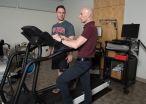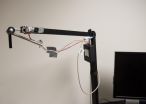(Press-News.org) COLUMBUS, Ohio - Exercise researchers have developed a new treadmill that automatically changes speed to match the pace of the runner.
The automated treadmill uses sonar to tell exactly where the runner is on the treadmill. If the runner picks up pace and moves toward the front of the running belt, the speed automatically increases. If the runner slows down and moves toward the back, the speed decreases.
The result is a treadmill experience that is much closer to walking or running outdoors, said Steven T. Devor, associate professor of kinesiology at The Ohio State University.
"If you're running outside and you want to speed up or slow down, there is no button to push. It is the same with this new automated treadmill," Devor said.
"It is seamless and feels completely natural. You just go."
Devor developed the new automated treadmill with Cory Scheadler, a former graduate student at Ohio State who is now an assistant professor at Northern Kentucky University.
The researchers revealed the automated treadmill in a study published online in the journal Medicine & Science in Sports and Exercise.
Devor said the device is a finished prototype in his lab and is nearly ready for commercialization. As an incentive for a fitness equipment manufacturer to make the investment necessary to turn the automated treadmill into a product ready for use at fitness clubs, Ohio State recently filed a patent application covering the treadmill's novel features.
Devor said the potential upside of the automated treadmill for athletes and anyone that uses a treadmill in a gym is obvious. When running or walking outside, people naturally speed up and slow down all the time without doing it consciously. But with a regular treadmill, you have to manually adjust every change in speed.
"So many people call it the 'dreadmill.' It is boring and monotonous. An automated treadmill makes the experience much more natural and you can just run without thinking of what pace you want to set," he said.
The researchers developed the new setup using off-the-shelf products. They started with an inexpensive sonar range finder, which is used to measure the distance between an object and the sonar device. They attached it to a microcontroller and a computer, which was linked to the electronics in the treadmill.
The sonar is set up behind the treadmill and aimed at the runner's back, just between the shoulder blades.
When the runner is in the middle of the running belt (measured from front to back), the speed of the treadmill stays the same. If the sonar senses that the runner is moving farther away, that means the runner is picking up speed and the sonar microcontroller sends a signal to the treadmill to speed up the belt in varying increments of speed. The speed increases until the runner returns to the middle of the belt.
If the sonar senses the runner is getting closer to the device, a signal tells the treadmill to slow down until the runner returns to the middle.
"It is all seamless and the runner doesn't even know that it's happening," Devor said.
Development of the prototype took a lot of trial and error before the researchers got all the parts to work together flawlessly. In early versions, the belt would speed up and slow down unpredictably. But now it works smoothly and reacts very quickly - so quickly that Scheadler, an elite runner, could break into a fast sprint on the automated treadmill and still not hit the front of the device, Devor said.
While the automated treadmill has a high potential future in the nation's fitness clubs, the article in Medicine & Science in Sports & Exercise documents its immediate value for exercise researchers.
Devor and Scheadler found that the automated treadmill did a better job than standard treadmills at providing an accurate measure of an athlete's aerobic capacity.
Most elite athletes - and increasingly many regular exercisers - have had their aerobic capacity measured through maximal oxygen consumption (or VO2 max) tests.
These tests, often done on treadmills, measure the maximum volume of oxygen that an athlete can use. The tests involve athletes pushing themselves to exhaustion in a treadmill test while wearing a mask that measures oxygen use.
In this study, the researchers had 13 experienced endurance runners take a VO2 max test using both a standard treadmill and the automated treadmill. Results showed that the athletes improved their VO2 max scores by 4 to 7 percent using the automated treadmill.
That's important, Devor said, because VO2 max scores are vital when developing heart rate training zones. These heart rate zones guide exercisers in using the right amount of effort when they are in training.
"If you have a more accurate VO2 max score, your heart rate zones are more accurate and your training will be more effective," he said.
Devor said he is continuing to improve the automated treadmill and use it for research. He's not sure when it will be ready to commercialize, but he is excited about the prospects.
"I think this automated treadmill would be appealing to anyone who has ever called it a 'dreadmill.'"
INFORMATION:
Contact: Steven T. Devor: 614-688-8436; Devor.3@osu.edu
Written by Jeff Grabmeier, 614-292-8457; Grabmeier.1@osu.edu
Returning to everyday life and resuming work in one's regular occupation are common goals of transplant patients, yet not all who undergo lung transplantation can go back to work. In an original article in Deutsches Ärzteblatt International (Dtsch Arztebl Int 2015; 112: 213-9), Hendrik Suhling and coauthors report the findings of the first study ever performed in Germany on the percentage of lung-transplant patients who resume employment after transplantation and the reasons that keep the others from going back to work.
In a cross-sectional study, these researchers ...
CAMBRIDGE, MA -- The human immune system is poised to spring into action at the first sign of a foreign invader, but it often fails to eliminate tumors that arise from the body's own cells. Cancer biologists hope to harness that untapped power using an approach known as cancer immunotherapy.
Orchestrating a successful immune attack against tumors has proven difficult so far, but a new study from MIT suggests that such therapies could be improved by simultaneously activating both arms of the immune system. Until now, most researchers have focused on one of two strategies: ...
CAMBRIDGE, Mass., April 14 - A new study from the Forsyth Institute is helping to shed more light on the important connection between the mouth and heart. According to research recently published online by the American Heart Association, scientists at Forsyth and Boston University have demonstrated that using an oral topical remedy to reduce inflammation associated with periodontitis, more commonly known as gum disease, also results in the prevention of vascular inflammation and can lower the risk of heart attack.
This study is the first time researchers anywhere have ...
Phoenix, AZ (April 14, 2015) - Researchers have characterized three different brain imaging changes in individuals with Down syndrome, who are at very high risk for development of Alzheimer's disease, even before the onset of progressive memory and thinking problems. Their findings could help set the stage to evaluate promising treatments to slow down or prevent the onset of Alzheimer's symptoms in these individuals, according to a study published in Alzheimer's & Dementia.
The scientists at Banner Sun Health Research Institute (BSHRI) and Banner Alzheimer's Institute ...
Composite materials used in aircraft wings and fuselages are typically manufactured in large, industrial-sized ovens: Multiple polymer layers are blasted with temperatures up to 750 degrees Fahrenheit, and solidified to form a solid, resilient material. Using this approach, considerable energy is required first to heat the oven, then the gas around it, and finally the actual composite.
Aerospace engineers at MIT have now developed a carbon nanotube (CNT) film that can heat and solidify a composite without the need for massive ovens. When connected to an electrical power ...
WASHINGTON, DC - April 14, 2015 - A new study has demonstrated that genetically modified Salmonella can be used to kill cancer cells. The study is published in this week's issue of mBio, an American Society for Microbiology online-only, open access journal.
"There has long been interest in using genetically engineered microbes to target and destroy cells within solid tumors. I think this study goes a significant way in developing some strategies that will help in the overall means of using Salmonella as part of a cancer therapy," said Roy Curtiss, III, PhD, who was involved ...
LOS ANGELES (EMBARGOED UNTIL 7 A.M. EDT on APRIL 14, 2015) - An injection of stem cells into the eye may soon slow or reverse the effects of early-stage age-related macular degeneration, according to new research from scientists at Cedars-Sinai. Currently, there is no treatment that slows the progression of the disease, which is the leading cause of vision loss in people over 65.
"This is the first study to show preservation of vision after a single injection of adult-derived human cells into a rat model with age-related macular degeneration," said Shaomei Wang, MD, ...
Scientists at the University of Southampton have shown that higher muscle mass is strongly linked with healthier bone development in children.
Researchers also found no relationship between fat mass and bone development, indicating it is not an important factor in childhood skeletal strength.
A new study, published in the journal Bone, by researchers from the University's Medical Research Council Lifecourse Epidemiology Unit shows a link between the amount of lean muscle and healthy bone development, indicated by the size, shape and density of limb bones, in children ...
Methane, a highly effective greenhouse gas, is usually produced by decomposition of organic material, a complex process involving bacteria and microbes.
But there is another type of methane that can appear under specific circumstances: Abiotic methane is formed by chemical reactions in the oceanic crust beneath the seafloor.
New findings show that deep water gas hydrates, icy substances in the sediments that trap huge amounts of the methane, can be a reservoir for abiotic methane. One such reservoir was recently discovered on the ultraslow spreading Knipovich ridge, ...
Researchers at Uppsala University have, together with researchers from Turku and Bergen, discovered a new biomarker which makes it possible to identify women with uterine cancer who have a high risk of recurrence. The findings were recently published in the journal Gynecologic Oncology.
Endometrial cancer of the uterus is the most common form of gynecologic cancer in Europe and North America. The treatment primarily consists of removing the uterus and in some cases offering chemotherapy if the risk of recurrence is deemed high.
The current study looks at the amount ...


